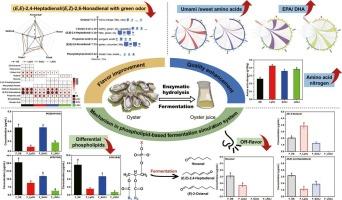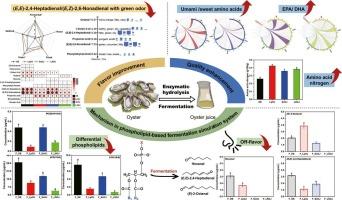Flavor formation mechanisms based on phospholipid fermentation simulation system in oyster juice co-fermented by Lactiplantibacillus plantarum and Saccharomyces cerevisiae
IF 8.5
1区 农林科学
Q1 CHEMISTRY, APPLIED
引用次数: 0
Abstract
Oyster juice was co-fermented with Lactiplantibacillus plantarum 3-B and Saccharomyces cerevisiae 7-C, and the quality of the oyster juice and the relationships between phospholipids and flavor formation were investigated. The olfactory odor intensities of (E,E)-2,4-heptadienal and (E,Z)-2,6-nonadienal, which impart off-flavors, were reduced in the co-fermented oyster juice in comparison with the unfermented juice. Co-fermentation resulted in an increase of 5.34 % in docosahexaenoic acid and 20.22 % in eicosapentaenoic acid. The flavor formation mechanisms were explored using a phospholipid-based fermentation simulation system. The levels of the differential phospholipids lysophosphatidylcholine 15:0, lysophosphatidylcholine 16:0, and phosphatidylethanolamine 20:0/16:0 in the co-fermented system decreased by 25.13 μg/mL, 6.87 μg/mL, and 0.30 μg/mL, respectively. Hexanal, (E,E)-2,4-heptadienal, and (E)-2-octenal were not detected in the co-fermented system. This study provides a novel approach to the processing of oyster juice and examines the phospholipid-related pathways involved in flavor formation.


基于植物乳杆菌和酿酒酵母共同发酵牡蛎汁磷脂发酵模拟系统的风味形成机制
用植物乳杆菌 3-B 和酿酒酵母 7-C 共同发酵牡蛎汁,研究了牡蛎汁的质量以及磷脂和风味形成之间的关系。与未发酵的蚝汁相比,共同发酵的蚝汁中产生异味的(E,E)-2,4-庚二烯醛和(E,Z)-2,6-壬二烯醛的嗅觉气味强度降低。联合发酵使二十二碳六烯酸和二十碳五烯酸分别增加了 5.34% 和 20.22%。使用基于磷脂的发酵模拟系统探索了风味形成机制。在共同发酵体系中,差异磷脂溶血磷脂酰胆碱 15:0、溶血磷脂酰胆碱 16:0 和磷脂酰乙醇胺 20:0/16:0 的含量分别下降了 25.13 μg/mL、6.87 μg/mL 和 0.30 μg/mL。在共发酵体系中未检测到己醛、(E,E)-2,4-庚二烯醛和(E)-2-辛烯醛。这项研究为牡蛎汁的加工提供了一种新方法,并研究了参与风味形成的磷脂相关途径。
本文章由计算机程序翻译,如有差异,请以英文原文为准。
求助全文
约1分钟内获得全文
求助全文
来源期刊

Food Chemistry
工程技术-食品科技
CiteScore
16.30
自引率
10.20%
发文量
3130
审稿时长
122 days
期刊介绍:
Food Chemistry publishes original research papers dealing with the advancement of the chemistry and biochemistry of foods or the analytical methods/ approach used. All papers should focus on the novelty of the research carried out.
 求助内容:
求助内容: 应助结果提醒方式:
应助结果提醒方式:


